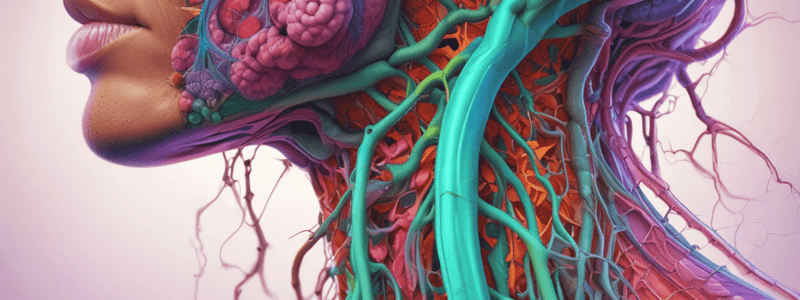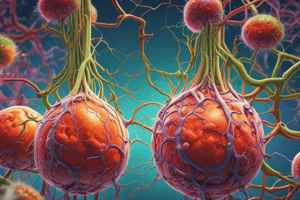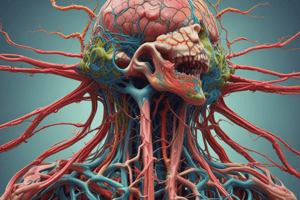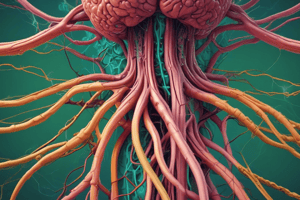Podcast
Questions and Answers
Which of the following statements about B cells is correct?
Which of the following statements about B cells is correct?
Which of the following is true about T cells?
Which of the following is true about T cells?
Which of the following statements about plasma cells is incorrect?
Which of the following statements about plasma cells is incorrect?
Which of the following is true about Natural Killer (NK) cells?
Which of the following is true about Natural Killer (NK) cells?
Signup and view all the answers
Which of the following statements about lymphoid organs is correct?
Which of the following statements about lymphoid organs is correct?
Signup and view all the answers
Which of the following statements about lymph nodes is incorrect?
Which of the following statements about lymph nodes is incorrect?
Signup and view all the answers
What is the primary function of the spleen?
What is the primary function of the spleen?
Signup and view all the answers
What is the primary role of tonsils in the immune system?
What is the primary role of tonsils in the immune system?
Signup and view all the answers
Which of the following statements about mucosa-associated lymphoid tissue (MALT) is incorrect?
Which of the following statements about mucosa-associated lymphoid tissue (MALT) is incorrect?
Signup and view all the answers
Which of the following structures are NOT considered secondary lymphoid organs?
Which of the following structures are NOT considered secondary lymphoid organs?
Signup and view all the answers
What is the primary function of germinal centers in lymph nodes and nodules?
What is the primary function of germinal centers in lymph nodes and nodules?
Signup and view all the answers
What is the primary function of the lymphatic system?
What is the primary function of the lymphatic system?
Signup and view all the answers
Which of the following is NOT considered part of the lymphatic system?
Which of the following is NOT considered part of the lymphatic system?
Signup and view all the answers
What is the primary function of lymph nodes?
What is the primary function of lymph nodes?
Signup and view all the answers
What is the difference between the innate and adaptive immune responses?
What is the difference between the innate and adaptive immune responses?
Signup and view all the answers
What is the primary function of B cells?
What is the primary function of B cells?
Signup and view all the answers
Which type of T cell is responsible for directly killing infected or cancerous cells?
Which type of T cell is responsible for directly killing infected or cancerous cells?
Signup and view all the answers
What is the main difference between the primary and secondary immune response?
What is the main difference between the primary and secondary immune response?
Signup and view all the answers
Which class of antibody is primarily responsible for providing protection at mucosal surfaces?
Which class of antibody is primarily responsible for providing protection at mucosal surfaces?
Signup and view all the answers
What is the main mechanism by which regulatory T cells suppress the immune response?
What is the main mechanism by which regulatory T cells suppress the immune response?
Signup and view all the answers
Which type of T cell is responsible for regulating the activity of B cells and their differentiation into plasma cells?
Which type of T cell is responsible for regulating the activity of B cells and their differentiation into plasma cells?
Signup and view all the answers
What is the main function of IgE antibodies in the immune system?
What is the main function of IgE antibodies in the immune system?
Signup and view all the answers
What is the main mechanism by which the body fights against fungal infections?
What is the main mechanism by which the body fights against fungal infections?
Signup and view all the answers
What is the purpose of the negative selection process during T cell development in the thymus?
What is the purpose of the negative selection process during T cell development in the thymus?
Signup and view all the answers
What is the main difference between active and passive immunity?
What is the main difference between active and passive immunity?
Signup and view all the answers
What is the main function of the IgM antibody class?
What is the main function of the IgM antibody class?
Signup and view all the answers
What is the primary function of Bronchus-associated lymphoid tissue (BALT)?
What is the primary function of Bronchus-associated lymphoid tissue (BALT)?
Signup and view all the answers
Which of the following is NOT considered a 'barrier defense' as described in the text?
Which of the following is NOT considered a 'barrier defense' as described in the text?
Signup and view all the answers
Which of the following is a key function of the complement system as described in the text?
Which of the following is a key function of the complement system as described in the text?
Signup and view all the answers
What is the primary function of interferons as described in the text?
What is the primary function of interferons as described in the text?
Signup and view all the answers
Which of the following is a key difference between the primary and secondary adaptive immune responses as described in the text?
Which of the following is a key difference between the primary and secondary adaptive immune responses as described in the text?
Signup and view all the answers
What is the primary role of antigen presenting cells in the adaptive immune response as described in the text?
What is the primary role of antigen presenting cells in the adaptive immune response as described in the text?
Signup and view all the answers
What is the primary function of natural killer (NK) cells in the innate immune response as described in the text?
What is the primary function of natural killer (NK) cells in the innate immune response as described in the text?
Signup and view all the answers
How do pattern recognition receptors (PRRs) on innate immune cells contribute to the innate immune response as described in the text?
How do pattern recognition receptors (PRRs) on innate immune cells contribute to the innate immune response as described in the text?
Signup and view all the answers




